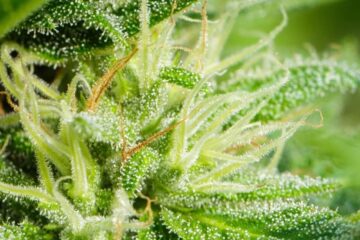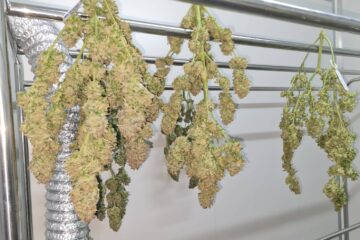Guide to Cannabis Nutrient Deficiencies – symptoms and solutions
Locate cannabis nutrient deficiencies to prevent your plants from dying! Wondering how to that? Use my guide with symptoms and solutions.
Cannabis plants can be affected by a range of nutrient deficiencies and excesses throughout their cultivation, whether grown indoors or outside. They require several specific nutrients to successfully grow and develop.
When growing cannabis, it is important to get to grips with the signs and symptoms of nutrient excesses and deficiencies. Sometimes, people confuse deficiency with something else, and misdiagnosis or the wrong treatment could easily kill your plants.
I will show you how to spot, monitor and solve nutrient imbalances in the cultivation of cannabis, which could have an impact on the final yield and overall quality of the buds.
The definition of nutrient deficiencies
A deficiency is determined in the following way: a deficiency that becomes apparent by certain symptoms and resulting in a pathology, which can affect the plant as a whole or in part.
Cannabis nutrient deficiencies are more frequent in the case of outdoor culture than inside, and the reason for this is simple; it is often impossible to know the history of the soil as well as its exact composition.
Deficiencies in the context of indoor cultivation usually occur following repetitive use of the substrate culture after culture, in the long run, it becomes depleted and poor quality. To overcome this problem, you should systematically change the soil of your pot with each crop. At the same time, after a crop, disinfect your pots with bleach, remembering to rinse the pot well.
If you scrupulously follow these rules, the probability of nutrient deficiencies is rare or non-existent.
Another important point is the fact that a deficiency is always treated by a specific treatment. You can’t cure a deficiency by simply increasing the amount of fertilizer. Always keep in mind that adding a generic fertilizer will either cure the problem but will increase the levels of factors not affected by the deficiency, which will result in overfeeding of factors that are not in deficit.
A complete crop cycle can be carried out without any problem and without the addition of fertilizer with a suitable new crop. The addition of additives is not a necessity. Cannabis growers who use additives do so for the sake of perfect plants and/or increasing the yield.
Some deficiencies are not visible if the deficiency stage is not at its peak. However, this beginning of imperceptible deficiency can lead to the development of certain diseases, because the plant is weaker, and cannot manage to defend itself. When there is a disease, the symptoms are usually localized and tend to spread.
Water – overwatering and underwatering
Underwatering is easily recognizable. The cells of the plant become rigid when sufficient water is present in the cells. If the earth dries completely, these cells lose stiffness because there is not enough water pressure. First, the lower leaves hang, and the situation moves upward until the top of the plant collapses.
How to treat: Treatment is easy, simply water your plants immediately. Place the entire plant in a bucket of water for a few hours until it has had a chance to have a good drink. However, do not overwater or let the roots stand in water or they will rot.
During the flowering stage, it is even more important to let the surface of the earth dry before watering completely again. Flowering is when plants are most likely to rot. You don’t want to keep the surface of the earth moist, because it raises the humidity of the garden and promotes rot and mold. Water the plants fully. You want to maximize the growth of flowers to harvest strong, tall buds.
Light
Watch out for plants that curve towards the light source or seem to grow in a frantic way to get closer to the light. Leaves are abnormally erect up and the plant grows in a leggy thin way rather than a compact bush.
This frequently occurs to plants behind a window.
Treatment: Bring the light source closer to the top of the plant. Move the plant to a better position. Investigate low-stress training which optimizes light so it can reach more areas of foliage, often dramatically increasing the yield.
During the growth phase, it is a good idea to use artificial light with a strong blue spectrum. When the plants are in their flowering phase, switch to light with a strong red spectrum.
Nitrogen (N)
Symptoms: Plants show a lack of energy, slow growth and are generally weak and rickety. Quality and performance will be significantly reduced. Older leaves turn yellow due to lack of chlorophyll. The color of nitrogen defficient plants will also be light green to yellow color on older leaves, these leaves may die and fall. Chlorosis will eventually spread throughout the plant. Stems, petioles and lower leaf surfaces may turn purple (however, do not overuse fertilizer as it is a very small lack that can sometimes be naturally filled when the roots grow and meet sources of nutrients in the earth).
Treatment: Application of a specific fertilizer NPK 3-0-0 or use of fish fertilizer.
Phosphorus (P)
Symptoms: Small leaves and slow-growing, unusually dark green plants that grow very slowly, with the leaves curving down along the edges. With P deficiency, the lower leaves may have a red or purple color in or along their veins.
Partly black/purple necrotic leaves that tend to curl in on themselves.
Treatment: If you think your plants may have a P deficiency, fertilize with P or with a general fertilizer rich in P but take care not to overdose.
Potassium (K)
Symptoms: Symptoms of K deficiency begin at the base of the plant, where you will see yellowed areas, or necrotic grey or rusty areas, and spots that start at the ends and along the leaf edges of the main stem. Unless you tackle the deficiency, the leaf tissues will continue to yellow and die starting at the edges and progressing inward. Rusty, brown, or grey, pinhead-sized spots may appear on leaves and stems. Plants with a K deficiency may be the largest in the garden. Stems and petioles often develop a red or purple color. The diseased leaves are more easily separated from the plant than their healthy counterparts.
Treatment: Feed with a potassium fertilizer. You can use a homemade solution based on ash if you have a fire or by composting a banana peel.
Softened water (domestic purification system) can cause sodium burn and symptoms of K deficiency, among a number of other problems.
Sulphur (S)
Symptoms: The symptoms of a Sulphur deficiency strongly resemble a lack of nitrogen: light green discoloration in one or more large, mature leaves.
Strong purple discoloration in and on the stems (by the production of the anthocyanin pigment)
Many leaves become discolored and the light green color changes in some places to deep yellow.
When there is an extreme lack of Sulphur, the plant will have several dark yellow leaves, with purple stems; growth and flowering will cease.
Treatment:
- Specific corrector fertilizer
- Epsom salts
- PH control
- Onion juice diluted in the water when watering
Boron
Symptoms: Boron-deficient plants have abnormally friable shoots and one of the earliest symptoms is non-extension of the root tips. Apical meristems of stems and roots often die. The tips of the roots often become swollen and discolored. Internal tissues can decompose and become subject to fungal diseases. The leaves show various symptoms that include: drying, thickening, curling, wilting, and chlorotic or necrotic spots.
Treatment: If you think your plants may have a lack of boron, some cardboard ash may be enough to solve the problem. Some gardening authorities recommend using Borax as a source of boron, (available from pharmacies) but you only need a very little, about a teaspoon per 10 square meters of soil.
Note – You are far more likely to have a toxic excess of boron than a deficiency. Only 20 PPM is needed for the plant; at a slightly higher level, it becomes toxic.
Molybdenum (Mo)
Symptoms: This often causes interveinal chlorosis that occurs first on old leaves, then spreads to the entire plant. Young leaves are severely twisted and may eventually die. Molybdenum deficiencies frequently resemble those of nitrogen (N), with old chlorotic leaves, curved edges and stunted growth.
Treatment: Specific fertilizer. Adding lime can increase the amount of molybdenum.
Magnesium (Mg)
Symptoms: The low leaves become spotted, yellowing, the edges the leaves curl upwards.
Treatment: Add a little magnesium sulphate to your watering solution (easily found in pharmacies).
Iron (Fe)
Symptoms: Yellowing leaves from inside to outside, the veins usually remain green. An iron deficiency is easy to misdiagnose. It is usually first noticeable on the freshest growth on the upper branches of the plant.
Treatment: Flushing with pure water (pH 6.0) is a good starting point. A good quality substrate feed is also necessary from the early growing stages onwards.
Copper (Cu)
Symptoms: Deficiencies of Copper (Cu) are extremely rare; so take care not to confuse this deficiency with the symptoms of fertilizer overdose. If you have regularly applied N-rich fertilizers, stop and irrigate with pure water for a while. The shoots and young leaves show chlorosis between the veins, and necrotic spots and a leaf border that develops and can turn to copper or grey. Sometimes the entire plant is a little soft, even though the plant has been well watered.
Treatment: In the unlikely event of a Cu deficiency, feed through the leaves with a fungicide containing Cu, such as copper sulfate (CuSO4), or with any general fertilizer that contains Cu. Copper is severely toxic in excess. In hydroponic gardens, concentrations above 1 ppm can completely kill plants. Look for another cause because Cu deficiency is extremely unlikely in any indoor garden.
Zinc (Zn)
Symptoms: Cannabis plants only require a tiny amount of zinc so this is not likely to be a massive problem. However, it is responsible for numerous functions, including the function of auxin, so it is worth knowing how to spot a zinc deficiency.
Slow growth, new shoots bunching together, leaves yellowing from the veins outward. If not treated, a zinc deficiency will progress with rust-colored spots and shriveled tips and edges of leaves. Eventually, buds will dry and drop off. Disaster!
Treatment: A fertilizer with zinc sulphate or zinc oxide. Use tap water.
In spite of what you may have read elsewhere, deficiencies in Fe, Zn, and Mn are quite common. They often give growers serious problems because they are rarely diagnosed properly, and the treatment requires more than simply adding a general fertilizer. Problems with Fe, Mn or Zn are very common in plants growing in areas with hard water. If you lower the pH of your water or nutrient solution to about 6.5, these three micronutrients become available to the plant. If any of the following symptoms occur in a hydroponic garden, lower the pH of your solution (make it more acidic) and apply the three nutrients in amounts only slightly above average concentrations.
Deficiencies of Fe, Mn and Zn often occur simultaneously, and alkaline (hard) water is responsible. You must apply the solutions concurrently to alleviate any serious consequences of these deficiencies. However, if distinctive signs of only a disability appear, apply only this element.
Calcium (Ca)
Symptoms: In the case of calcium deficiency, the oldest and largest leaves will show the symptoms first. It is not often the leaves below but rather at the top. This deficiency is characterized by the presence on the leaf of yellow-brown spots with a brown edge. The symptoms of such a deficiency appear quickly.
The first spots are visible on the older leaves after one or two weeks. The spots often start with small light brown dots, which will then grow larger.
After two weeks, they will multiply on the oldest leaves. They will also appear often on the edge of the sheet.
Treatment: The best way to eliminate the problem is to put lime in the soil well before planting. There are many forms of lime available in gardening stores, but avoid hydrated lime and slaked lime because it is too strong. Using dolomitic limestone in a medium form is recommended.
Most of the calcium in plants acts as a buffer against the accumulation of chemically similar but toxic elements.
Excess calcium is harmful to plants. It often hinders growth and can also lead to a lack of boron, manganese, zinc, magnesium and sometimes copper.
A fluctuating pH
Symptoms: Too high or too low a pH can turn nutrients into insoluble salts and compounds, some of which are actually toxic to plants. When you notice this, you may try to supplement the plant diet by adding more fertilizers to vary the pH even more and turning even more nutrients into non-assimilable elements. This type of problem is commonly seen in soil mixtures where the inconsistent mixing of components proves unsuitable for cultivation.
Treatment:
In hydroculture, if this type of problem appears, it is urgently necessary to buy pH buffers.
For soil culture, check the pH of the soil, if necessary, remove and change the substrate, water with a soil pH corrector, and control the pH of the water you use to water.
Using a Living Soil, you can avoid learning or memorizing all of this. A Living Soil usually issues like the above are avoided.
Kevin


